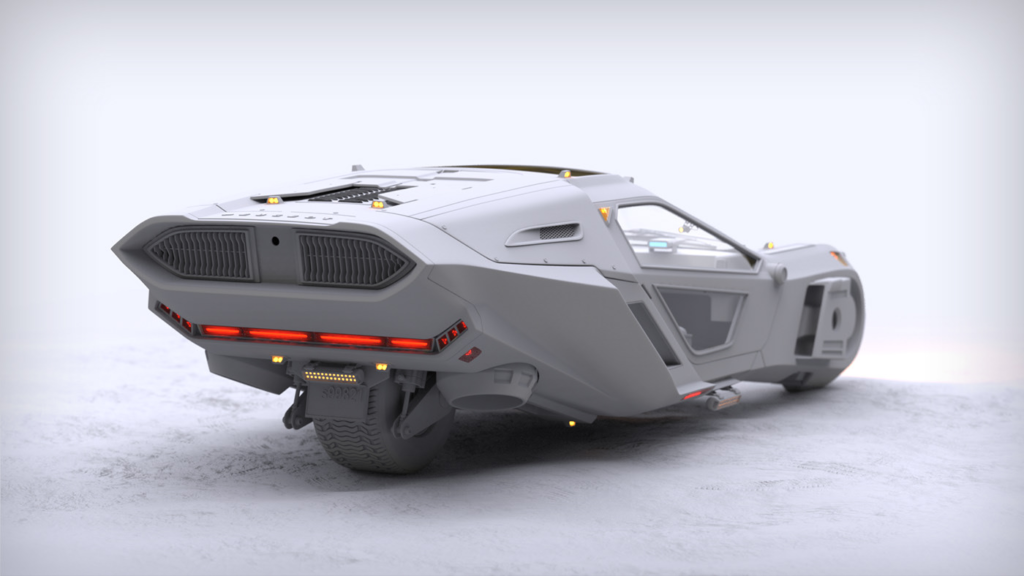Table of Contents
Tesla introduced the Cybertruck in 2019, and it’s been in the spotlight ever since. According to Forbes, the Cybertruck, with a luxurious starting price of over $100,000, is the third best-selling electric vehicle in the U.S., only surpassed in sales by Tesla’s Model Y and Model 3.
But have you ever looked at the Tesla Cybertruck and thought, “Why does it look like that?” “What were they thinking?” It’s a bold, polarizing design that has sparked countless memes and debates since its reveal in 2019.

However, what if I told you that this futuristic vehicle draws inspiration from several historical designs?
Let’s dive into the fascinating influences behind Cybertruck’s unique aesthetic.
Origins
The Tesla Cybertruck represents a radical departure from traditional truck designs, drawing inspiration from the wedge-shaped vehicles of the 1970s, such as the Lotus Esprit and Lancia Stratos. Its futuristic design features an angular, stainless steel body, reminiscent of past concepts but reimagined for modern electric vehicle technology.
Further going back in time, the cybertruck also draws inspiration from early 19th-century vehicles like the chuck wagon, a mobile kitchen of sort designed to meet the practical needs of cattle drivers during long journeys across the American West. It featured a modified covered wagon equipped with a “chuck box” for food storage and preparation, particularly used by cowboys to carry essential supplies and cook meals on the trail.
Elon Musk’s vision for the Cybertruck integrates historical ingenuity with advanced technology, positioning it as a symbol of innovation in the automotive industry.
Brutalism and Anti-Styling – Major Aspects of the Tesla Cybertruck Design
The Tesla Cybertruck embodies a unique blend of Brutalism and anti-styling, reflecting a departure from conventional automotive design norms. Brutalism, an architectural style characterized by its raw, unadorned materials and functional forms, resonates deeply in the Cybertruck’s aesthetic.
The vehicle’s exterior features a stark, angular design made from stainless steel, which is not only visually imposing but also emphasizes the material’s inherent qualities without cosmetic embellishments. This approach aligns with Brutalism’s ethos of honesty in construction, where the form follows function and the materials are presented in their most authentic state.

In addition to its Brutalist influences, the Cybertruck exemplifies anti-styling, a concept that rejects traditional notions of beauty and luxury in favor of a more utilitarian and straightforward design philosophy. Unlike many vehicles that prioritize sleek curves and polished finishes, the Cybertruck’s geometric shapes and flat surfaces challenge the idea that vehicles must be aesthetically pleasing to be functional.
This rejection of styling is intentional; it aims to convey a sense of ruggedness and practicality, appealing to consumers who value utility over superficial elegance. The Cybertruck’s design is not merely about aesthetics; it serves as a statement against the excesses of modern automotive styling, focusing instead on efficiency and purpose.
Historical Vehicles that Influenced the Tesla Cybertruck Design
Let’s take a look at some historical vehicles that Influenced the Tesla Cybertruck design:
1. The Lotus Esprit S1: The “Submarine Car” from The Spy Who Loved Me

The Lotus Esprit S1, introduced in the 1977 James Bond film The Spy Who Loved Me, is one historical design that’s often mentioned when discussing the Cybertruck. While the Esprit was a sports car rather than a truck, its sharp, wedge-like shape and its appearance as a submersible vehicle make it an easy parallel to Tesla’s design.
The idea of a car that combines functionality with a sleek, almost military look certainly feels like a callback to the Esprit. Elon Musk himself reportedly purchased the actual Lotus Esprit prop from the Bond movie for almost $1 million in 2013. He even mentioned that he was inspired by the concept of a “transforming” vehicle—a vision clearly realized in the versatility of the Cybertruck.
2. The DeLorean DMC-12: The Stainless Steel Icon from Back to the Future

You can’t talk about the Cybertruck without mentioning the DeLorean DMC-12, the famous stainless steel car from Back to the Future. With its unpainted stainless steel body and gull-wing doors, the DeLorean was an icon of 1980s design, and it’s easy to see how it might have influenced Tesla’s truck.
The DeLorean was as much a statement of style as it was a vehicle, and its design was a blend of futuristic and industrial aesthetics. With a similar stainless steel construction and distinctive look, the Cybertruck appears to be a spiritual successor to the DeLorean. As industrial design expert Alex Parker says, “The DeLorean DMC-12 didn’t follow trends; it set them. The Cybertruck is doing the same thing for a new generation.”
3. F-117 Nighthawk Stealth Fighter

Introduced in 1983, the F-117 Nighthawk Stealth Fighter significantly influenced the design of the Tesla Cybertruck through its innovative use of angular shape design.
The F-117’s unique design features flat, angled surfaces that scatter radar waves, making it nearly invisible to detection. This concept inspired the Cybertruck’s geometric and faceted exterior, which also emphasizes a bold departure from traditional vehicle aesthetics.
Tesla’s chief designer, Franz von Holzhausen, mentioned that the Cybertruck’s angles are reminiscent of stealth aircraft, showcasing a blend of function and futuristic design.
Both vehicles utilize advanced materials for their respective purposes. The F-117 was coated with radar-absorbent materials, while the Cybertruck’s exoskeleton is made from ultra-hard 30X cold-rolled stainless steel, designed for durability and resistance to dents and corrosion.
The F-117’s introduction during the Gulf War revolutionized military aviation and captured public imagination with its stealth capabilities. Similarly, the Cybertruck aims to disrupt the automotive industry by challenging conventional pickup truck norms. Elon Musk has cited the F-117 as an inspiration, highlighting how its design embodies a vision for the future of transportation.
4. Blade Runner Spinners

The Tesla Cybertruck’s design draws significant inspiration from the flying cars known as Spinners featured in Ridley Scott’s Blade Runner (1982). Elon Musk has openly referred to the Cybertruck as the “Blade Runner truck,” highlighting its sci-fi roots.
The Spinners are characterized by their angular shapes and futuristic aesthetics, which align closely with the Cybertruck’s geometric, faceted body. Both vehicles feature blunt angles and a metallic finish, creating a striking visual impact that evokes a sense of advanced technology. This connection is beyond superficial, as Musk aimed to capture a vision of the future that resonates with fans of science fiction.
5. The Lancia Stratos

The Lancia Stratos, particularly the Stratos Zero Prototype designed by Marcello Gandini in the 1970s, significantly influenced the design of the Tesla Cybertruck. The Stratos Zero is renowned for its radical wedge shape and sharp lines, which sought to redefine automotive aesthetics and functionality. This bold design philosophy resonates with Elon Musk’s vision for the Cybertruck, as both vehicles challenge traditional automotive norms.
The Stratos Zero aimed to provoke discussion about the future of car design. Its striking form and minimalist approach to features align with the Cybertruck’s emphasis on a utilitarian yet futuristic appearance. The Cybertruck’s angular silhouette and robust materials echo the Stratos’s innovative design, showcasing a commitment to functionality without sacrificing visual impact.
Moreover, both vehicles embody a sense of adventure and exploration. The Stratos was built for rally racing, emphasizing performance and agility, while the Cybertruck aims to cater to a new generation of drivers seeking versatility in their vehicles. Musk’s desire to create a vehicle that stands out in a crowded market mirrors Gandini’s goal of making a statement with the Stratos Zero.
Conclusion
The Cybertruck integrated these diverse influences into a cohesive design that challenged traditional truck aesthetics while also emphasizing utility, durability, and a forward-looking vision of transportation. It’s as if the Cybertruck isn’t trying to fit into any existing mold—it’s creating its own. Tesla’s ability to draw from these influences and craft a design that still feels fresh is a testament to their innovation in automotive design.
Perhaps, as more automotive giants explore the electric vehicle space, we’ll see how this fusion of history and futuristic ambition influences the trucks and vehicles of tomorrow.
You May Also Like:
- 18 Key Components of Electric Vehicles: A Complete Teardown
- Top 20 Autonomous Vehicle Companies in the U.S.
- 10 Fascinating Things to Know About the Tesla Cybercab

I’m Dr. Brandial Bright, also known as the AVangelist. As a dedicated and passionate researcher in autonomous and electric vehicles (AVs and EVs), my mission is to educate and raise awareness within the automotive industry. As the Founder and Managing Partner of Fifth Level Consulting, I promote the adoption and innovation of advanced vehicle technologies through speaking engagements, consulting, and research as we progress to level 5 fully autonomous vehicles.


